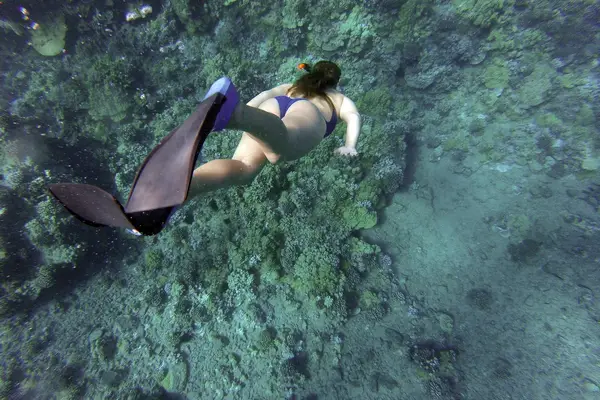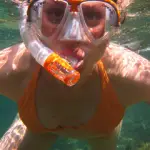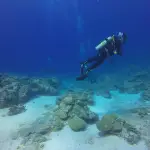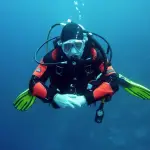
So you’ve decided to go snorkelling and you’re ready to set off, but then you find out the water is deeper than you thought. Whilst that’s not generally a problem if you’re snorkelling somewhere, it might be if you’re planning on diving down to the bottom. When I go snorkelling, I love to dive down myself. As far as I’m concerned it’s a part of snorkelling.
How far underwater do you go when snorkeling? How far you can go underwater when you’re snorkelling depends on how long you can hold your breath for. The longer you can hold your breath, the deeper you can go. You’ll also need to be able to equalise your ears with the increased water pressure. Your confidence in water may also play a part in how deep you go.
The best way to do more diving is to book yourself on a scuba diving liveaboard. You can check the latest and best deals on liveaboards using the using the following window:
The 7 factors that will affect how far underwater do you go when snorkelling?
There are a number of factors that will affect how far you can dive down to when you’re snorkelling. Some of these factors will be more relevant if you’re a complete beginner to snorkelling, versus if you’ve already been snorkelling before.
The more times you go snorkelling, the more your confidence will grow, and the better you’ll get. Let’s take a look at what might affect how far down you can go when you’re snorkelling.
Factors that will affect how far underwater you go when snorkelling
- How long you can hold your breath. In simple terms, the longer you can hold your breath, the further you can go underwater when you dive down.
- Whether or not you can equalise your ears. As you dive down below the surface, the pressure increases. The deeper you go, the higher the pressure and the more you will need to equalise the pressure in your ears to compensation. If you don’t equalise this pressure, you will experience pain and in the worst case scenario, you could burstIf you’re not able to clear your ears when you attempt to dive down, you’ll not be able to go very far down.
- Your mindset and how comfortable you are about diving down under the surface when you’re snorkelling.
- Whether or not you’re snorkelling with fins (or flippers), as these will help to propel you down further.
- If you are a beginner snorkeler, you may not be able to dive down as far as an experienced snorkeler as it takes a bit of technique to master the duck-dive. The duck-dive is the same terminology used by surfers to duck-under an in-coming wave, but for snorkelers it’s the technique used to dive down.
- Your personal buoyancy status and how easy it is for you to dive under the water. Everyone’s buoyancy is different, for example a skinny person with little fat reserves will be more likely to be negatively buoyant. Whereas a person who is carrying a few extra pounds let’s say, will be likely to be positively buoyant. The person who is negatively buoyant will find it far easier to dive down deeper than the positively buoyant person.
- What you are wearing will affect your ability to dive down. For example, if you’re wearing a wetsuit or a drysuit for snorkelling, this will add to your buoyancy. If you don’t compensate for this added buoyancy by using a weight belt, you may struggle to even break the surface, let alone dive down to the bottom.
How a snorkel works underwater when diving down
If you are new to snorkelling it’s important you understand how a snorkel works underwater. Diving down with a snorkel is not like scuba diving where you can breath underwater.
But instead you need to hold your breath until you get back to the surface again. Also, you will need to master blowing the water out of your snorkel, unless you use a dry-snorkel.
How do you dive down when snorkelling?
The best way to dive down when you’re snorkeling is to do a duck-dive.
Before you duck dive take a few deep breaths first, but don’t hyperventilate. Relax yourself and and move as little as possible to let your body prepare itself for a breath-hold.
Then just before you dive down, take one last big breath. Then bend 90 degrees at the waist so that your head and body becomes submerged and vertical in the water. Your legs should now also be vertical, which is what will help to dive down.
Once your fins are under the surface, use these to propel yourself down to the bottom.

Will I need a weight belt to dive down deep?
The only time I use a weight belt when I’m snorkelling is if I’m wearing a wetsuit. But then I’m slightly negatively buoyant and tend not to need one otherwise. I find it easy to dive down without a weight belt if I’m snorkelling in just swim-shorts.
Whether you need a weight belt to help you get down will depend on your own personal buoyancy. If you are positively buoyant, diving down will be more difficult and a weight belt will make it easier.
But also, if you’re like me and slightly negatively buoyant, or if you are neutrally buoyant, when you wear a wetsuit this will add to your buoyancy. This is why a weight belt becomes necessary.
The best way to test your buoyancy is to jump in the water in your swimming costume, take a shallow breath and put your arms by your side. Don’t kick your feet and see if you float or sink below the surface.
If your head remains above the surface, this indicates you’re positively buoyant, whereas if you sink below the surface, you’re negatively buoyant.
Why dive down below the surface when snorkelling?
It’s not a requirement when you’re snorkelling to dive down underwater. Many snorkelers simple stay on the surface. But I like to dive down, as it gives me a chance to see things up close.
The reason why you may wish to dive down would be if the visibility isn’t so good. Although, I don’t enjoy snorkelling in low-visibility as it makes for an unpleasant experience. With low visibility you can’t really see much, which means you have to constantly dive down to see the bottom. This becomes exhausting.
The other reason I dive down is if you see something and it goes under a ledge. If you dive down you can get a better look under the ledge.
Other reasons why some snorkelers dive down is to collect things from the seabed (check if you’re allowed to do this first) or if they are hunting for fish or crabs and lobsters.
For those of your who are planet-friendly, you may also want to dive down to pick up rubbish from the bottom. I am always doing this myself, which is why I take a collecting bag with me just in case.
Other considerations about how far down to dive then snorkelling
The other things to consider about how far down to dive down when snorkelling include the following:
- How deep the bottom is from the surface: If for example the bottom is say 10 metres away (32 feet), unless you’re really good at diving down and you’re able to hold your breath for quite some time, there’s no point in diving down in any event. That being said, you may not want to snorkel over water that is 10 metres deep in any event, as it’s far better to snorkel in the shallows.
- What’s to see by diving down: There’s no point in diving down to the bottom for the sake of it. If there’s nothing to see by getting up closer, it doesn’t matter how deep it is.
- If you’re snorkelling in very shallow water: If the water depth below you is very shallow, let’s say less than one metre or three foot or less, there’s probably no point in diving down in any case, as the bottom will be very close to you. Diving down in water this shallow may not benefit you in any case.
- The water visibility: Sometimes the reason for diving down is because you’re not able to see the bottom due to poor visibility. This will be an added reason for diving down more often than not so as to see things on the bottom. However, having said that, it’s actually not that much fun snorkelling in water with poor visibility. It’s also quite hard work if you’re having to dive down constantly in order to see things on the bottom. The whole idea for most snorkelers is to dive down to take a closer look at something you’ve spotted on the bottom.
- If you’re using a snorkel mask, you won’t be able to dive down. This is because you’ll not be able to equalise your ears as you dive down.
I hope you enjoyed this article about how far underwater do you go when snorkelling
I’d love to hear from you. Tell us about your adventures of diving and snorkelling. Please use the comments section below. Please also share your photos. Either from your underwater cameras or videos from your waterproof go-pro’s!
If this article hasn’t answered all of your questions. If you have more questions either about snorkelling or scuba diving (or specifically about how far underwater do you go when snorkelling), please comment below with your questions.
There will also be many more articles about scuba and scuba diving safety tips (and on snorkelling too) for you to read and learn about this fabulous sport.
Have fun and be safe!




